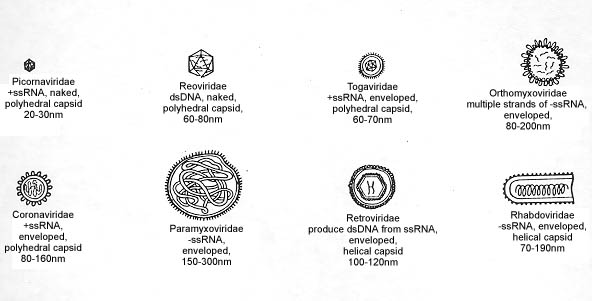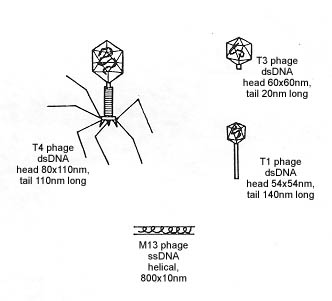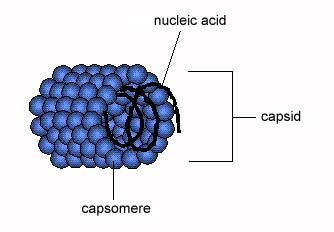10.2: Size and Shapes of Viruses
- Page ID
- 3233
- Compare the size of most viruses to that of bacteria.
- List 4 shapes of viruses.
Size
Viruses are usually much smaller than bacteria with the vast majority being submicroscopic. While most viruses range in size from 5 to 300 nanometers (nm) , in recent years a number of giant viruses, including Mimiviruses and Pandoraviruses with a diameter of 0.4 micrometers (µm) , have been identified. For a comparison of the size of a virus, a bacterium, and a human cell, scroll down to how big is... on the Cell Size and Scale Resource at the University of Utah webpage (see Figure \(\PageIndex{1}\)A, Figure \(\PageIndex{1}\)B, and Figure \(\PageIndex{1}\)C),
Shapes



Figure \(\PageIndex{1}\)C: Sizes and Shapes of Viruses (Bacteriophages)
a. Helical viruses consist of nucleic acid surrounded by a hollow protein cylinder or capsid and possessing a helical structure (Figure \(\PageIndex{2}\)A).




b. Polyhedral viruses consist of nucleic acid surrounded by a polyhedral (many-sided) shell or capsid, usually in the form of an icosahedron (Figure \(\PageIndex{2}\)B).
- Transmission electron micrograph of Adenoviruses; courtesy of CDC.
- Transmission electron micrograph of poliomyelitis viruses; courtesy of CDC.
- Transmission electron micrograph of poliomyelitis viruses; courtesy of Dennis Kunkel's Microscopy.
c. Enveloped viruses consist of nucleic acid surrounded by either a helical or polyhedral core and covered by an envelope (see Figure \(\PageIndex{2}\)C and Figure \(\PageIndex{2}\)D).
- Transmission electron micrograph of Hepatitis B viruses; courtesy of CDC.
- Transmission electron micrograph of an Influenza A virus; courtesy of CDC.
- Transmission electron micrograph of HIV; courtesy of CDC.
- Transmission electron micrograph showing envelope and glycoprotein spikes Coronaviruses; courtesy of CDC.
- Transmission electron micrograph of herpes simplex viruses; courtesy of Dennis Kunkel's Microscopy.
d. Binal (complex) viruses have neither helical nor polyhedral forms, are pleomorphic or irregular shaped (Figure \(\PageIndex{3}\)), or have complex structures (Figure \(\PageIndex{2}\)F).

- Transmission electron micrograph of the bacteriophage coliphage T4; courtesy of Dennis Kunkel's Microscopy.
We just learned that most viruses are much smaller than bacteria.
- Compare the sizes of viruses and bacteria.
- Why are viruses able to be so much smaller than bacteria
Summary
- Viruses are usually much smaller than bacteria with the vast majority being submicroscopic, generally ranging in size from 5 to 300 nanometers (nm).
- Helical viruses consist of nucleic acid surrounded by a hollow protein cylinder or capsid and possessing a helical structure.
- Polyhedral viruses consist of nucleic acid surrounded by a polyhedral (many-sided) shell or capsid, usually in the form of an icosahedron.
- Enveloped viruses consist of nucleic acid surrounded by either a helical or polyhedral core and covered by an envelope.
- Binal (complex) viruses have neither helical nor polyhedral forms, have irregular shapes, or have complex structures.


